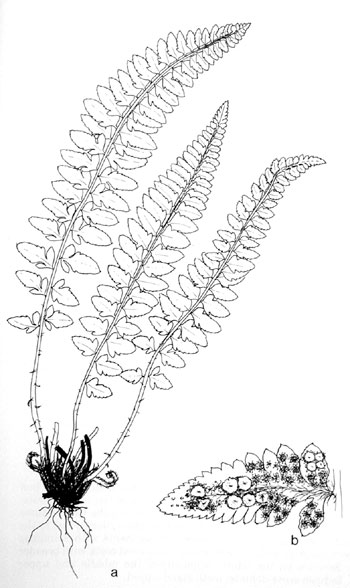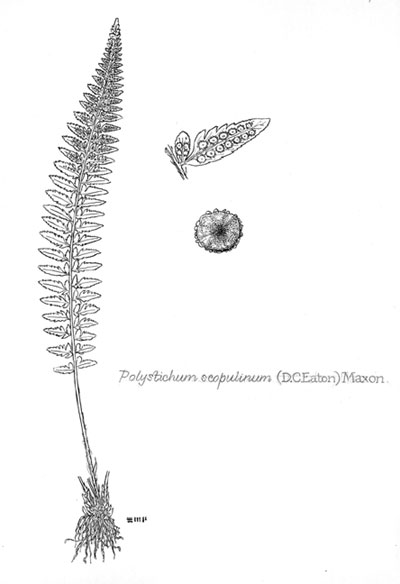| Polystichum scopulinum | ||
Mountain holly fern, rock sword fern | ||
|
Etymology
Scopulinum means of the rocks. See section marked Culture.
Description
Rhizome: erect, short, stout, scaly.
Frond: 40 cm high by 6 cm wide, evergreen, monomorphic, blade/stipe ratio: 2:1 to 4:1. Stipe: grooved, densely scaly but scales falling off above, light brown, abruptly diminishing in size upward, vascular bundles: 4 or more, in an arc. Blade: 1-pinnate-pinnatifid, but described also as merely 1-pinnate or in older specimen 2-pinnate, lanceolate, base narrowed, glossy, microscales narrowly lanceolate, sparse, on lower surface only, and falling soon. Pinnae: 20 to 40 pair, oblong-lanceolate, 1--3 cm, basal lobes (the upper one larger, eared outward) cut to the costa, the remainder of the pinna more accurately described as serrate, anadromic; margins serrate, spiny, 8-25 spines on each edge of the pinna; veins free, forked. Sori: round, touching at maturity, nearly covering the entire surface on the upper two-thirds of the frond, except for the basal lobes, in 1 row on both sides of the costa, indusium: peltate, central, sporangia: brown, maturity: late spring. Dimensionality: pinnae folded inward and twisted horizontally. Culture
Habitat: rock crevices and at base of boulders, serpentine to acidic substrates, usually exposed to full sun .
Distribution: British Columbia to Arizona, disjunct in Quebec, Newfoundland.
Hardy to -30�C, USDA Zone 4.
Synonyms
Aspidium aculeatum (Linnaeus) Swartz var. scopulinum D. C. Eaton Polystichum mohrioides (Bory) C. Presl var. scopulinum (D. C. Eaton) Fernald Aetopteron scopulinum House |
|
|
Notes
Compare to the similar P. kruckebergii, differentiated by the pinna margins: 8 or more, often 12, teeth here vs. 6 in P. kruckebergii, and the margin is much spinier in P. kruckebergii.
Parents P. imbricans and P. lemmonii. The former is distinctly 1-pinnate and the stipe is shorter with a blade/stipe ration greater than 4:1. The latter is not spiny and is distinctly 2-pinnate.
Compare to the similar P. kruckebergii, differentiated by the pinna margins: 8 or more, often 12, teeth here vs. 6 in P. kruckebergii, and the margin is much spinier in P. kruckebergii.
Parents P. imbricans and P. lemmonii. The former is distinctly 1-pinnate and the stipe is shorter with a blade/stipe ration greater than 4:1. The latter is not spiny and is distinctly 2-pinnate.

Polystichum scopulinum. a) fronds, blades widest at the middle; b) fertile pinna with about a dozen teeth. �Illustration by V. Fulford from Ferns and Fern Allies of Canada, William J. Cody and Donald M. Britton, 1989, � Agriculture Canada, used with permission. |
